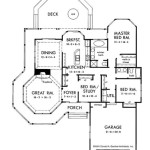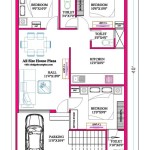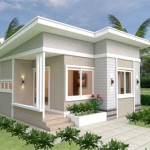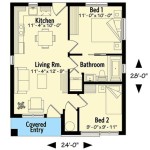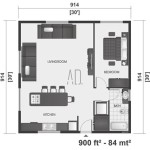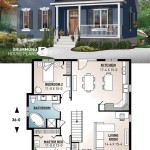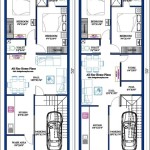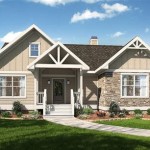House Plans From The 1950s: A Glimpse into Post-War American Domesticity
House plans from the 1950s offer a fascinating window into the aspirations and lifestyles of post-World War II America. This era witnessed a significant shift in housing trends, fueled by economic prosperity, a burgeoning middle class, and a desire for comfortable, modern living. Examining these plans reveals not only architectural styles but also prevailing social values and technological advancements that shaped the American home.
The end of the war brought with it a surge in population growth, often referred to as the "baby boom." This demographic change, coupled with government programs like the GI Bill, which provided affordable mortgages to veterans, created an unprecedented demand for housing. Developers responded with mass-produced homes, often built in suburban communities, designed to cater to this new family-oriented market. These homes, while often modest in size, represented a significant step up from the housing options available to many during the Depression and wartime years.
The architectural styles popular in the 1950s were diverse, reflecting the influences of modernism while still retaining elements of traditional design. Ranch homes, with their single-story layouts and low-pitched roofs, became incredibly popular, epitomizing the casual, informal lifestyle that many families desired. Cape Cod-style homes, with their symmetrical facades and steeply pitched roofs, also remained a common choice, offering a sense of comfort and familiarity.
Key Point 1: The Rise of the Ranch House
The ranch house is arguably the defining architectural style of the 1950s. Its popularity stemmed from its simplicity, affordability, and adaptability to various lot sizes. Characterized by a single-story layout, a low-pitched roof, and an open floor plan, the ranch house facilitated easy living and a connection to the outdoors. Large windows and sliding glass doors were common features, blurring the lines between the interior and exterior spaces. The emphasis was on practicality and functionality, making it ideal for young families with children.
The floor plans of ranch houses typically featured a living room that flowed seamlessly into the dining area, creating a more spacious and social environment. Bedrooms were often clustered together in a separate wing of the house, providing privacy for family members. The kitchen, often located near the dining area, was designed to be efficient and user-friendly, with modern appliances like refrigerators, stoves, and dishwashers becoming increasingly common features. Garages, either attached or detached, were also a standard component of the ranch house, reflecting the growing dependence on the automobile.
Beyond its practical advantages, the ranch house also embodied a particular aesthetic that resonated with the spirit of the 1950s. Its horizontal lines and understated elegance conveyed a sense of informality and relaxation. The use of natural materials, such as wood and brick, further enhanced its connection to the landscape. The ranch house became a symbol of the American dream, representing homeownership, family values, and suburban living.
Variations on the ranch house style included the "rambler," which was often larger and more sprawling, and the "split-level," which incorporated multiple levels to maximize space on smaller lots. These variations allowed for greater customization and adaptation to different family needs and preferences. The fundamental principles of the ranch house – simplicity, functionality, and connection to the outdoors – remained constant, making it a versatile and enduring style.
Key Point 2: Modern Appliances and Technological Integration
The 1950s witnessed a significant advancement in household appliances, transforming the way people lived and worked in their homes. These appliances, often marketed as labor-saving devices, aimed to simplify household chores and free up time for leisure activities. House plans from the era reflect this trend, with kitchens and laundry rooms designed to accommodate these new technologies.
Refrigerators, once considered a luxury, became a standard feature in most homes. These refrigerators were often larger and more technologically advanced than their pre-war counterparts, offering features like automatic defrost and separate compartments for different types of food. Stoves, both electric and gas, also became more sophisticated, with features like timers and temperature controls. The introduction of the dishwasher revolutionized kitchen cleanup, making it easier and faster to wash dishes.
Laundry rooms, often located in the basement or near the kitchen, were equipped with washing machines and dryers, eliminating the need for manual washing and clotheslines. These appliances significantly reduced the amount of time and effort required for laundry, freeing up time for other activities. Ironing boards and storage cabinets were also common features of the laundry room, providing a dedicated space for laundry-related tasks.
Beyond appliances, other technological advancements also impacted house design in the 1950s. Central heating and air conditioning became more prevalent, providing homeowners with greater control over their indoor climate. Television became a central form of entertainment, leading to the creation of dedicated television rooms or entertainment centers within the living room. Electrical outlets were strategically placed throughout the house to accommodate the increasing number of electrical devices.
The integration of these technologies into the home had a profound impact on daily life. It reduced the amount of time and effort required for household chores, freeing up time for leisure activities and personal pursuits. It also improved the comfort and convenience of the home, making it a more appealing and enjoyable place to live. House plans from the 1950s reflect this transformation, showcasing the importance of technology in shaping the modern American home.
Key Point 3: Emphasis on Family-Oriented Design
The 1950s was a period of strong family values, and this emphasis on family life is reflected in the design of homes from the era. House plans often prioritized spaces for family gatherings, children's play, and outdoor recreation. The goal was to create a comfortable and functional environment that fostered strong family bonds.
Open floor plans, particularly in ranch houses, encouraged interaction between family members. The living room, dining area, and kitchen often flowed seamlessly together, creating a more social and inclusive space. This allowed parents to supervise children while preparing meals or engaging in other activities. The absence of walls and barriers also made it easier to entertain guests and host family gatherings.
Bedrooms were typically clustered together in a separate wing of the house, providing privacy for family members while still allowing for easy access and supervision. Children's bedrooms were often designed with flexibility in mind, allowing them to be used for sleeping, playing, and studying. Playrooms or recreation rooms were also common features, providing a dedicated space for children to engage in games and activities.
Outdoor spaces were also considered an integral part of the family home. Backyards were often large and spacious, providing ample room for children to play and explore. Patios and decks extended the living space outdoors, creating a comfortable area for outdoor dining and relaxation. Barbecue grills and picnic tables were common features, encouraging families to spend time together in the fresh air.
The design of homes in the 1950s also reflected the growing importance of the automobile. Garages, either attached or detached, were a standard feature, providing a convenient place to park and store vehicles. Driveways were often designed to accommodate multiple cars, reflecting the increasing number of families with more than one vehicle. The emphasis on car ownership further reinforced the suburban lifestyle, where personal vehicles were essential for commuting and accessing amenities.
In conclusion, house plans from the 1950s offer a valuable glimpse into the lives and values of post-war Americans. The emphasis on suburban living, modern appliances, and family-oriented design shaped the architectural landscape and continues to influence housing trends today. Studying these plans provides insights into the social, economic, and technological forces that shaped the American home.

150 Vintage 50s House Plans Used To Build Millions Of Mid Century Homes We Still Live In Today Americana

150 Vintage 50s House Plans Used To Build Millions Of Mid Century Homes We Still Live In Today Americana

Vintage Real Estate Choose Your House From A 1958 Modern Living Homes Catalog The Inn

House Floorpans 1940s 1960s Technical Drawing

150 Vintage 50s House Plans Used To Build Millions Of Mid Century Homes We Still Live In Today Americana

The Best 50s Ranch House Design So Far A Retro Renovation Re Run

My New Obsession Vintage House Plans Aimee S Victorian Armoire

150 Vintage 50s House Plans Used To Build Millions Of Mid Century Homes We Still Live In Today Americana

Vintage House Plans Old Houses For

Luxury Ranch Rustic Craftsmanstyle House Plan 1950

